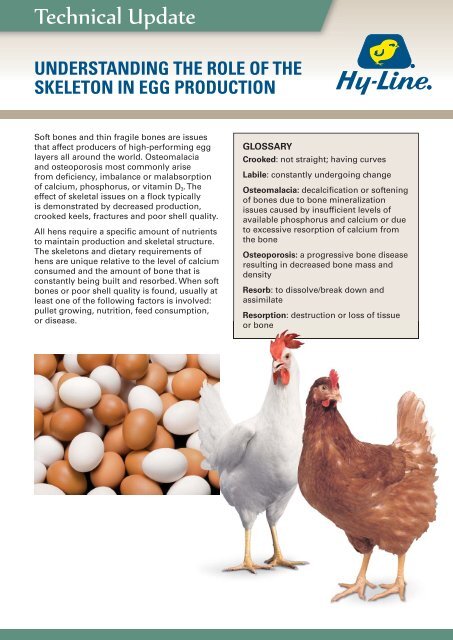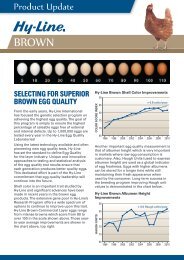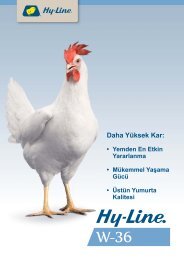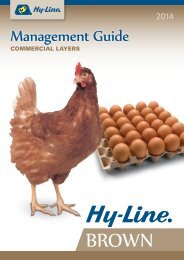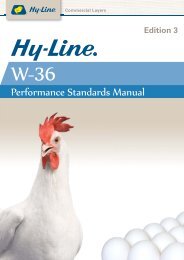Understanding the Role of the Skeleton in Egg Production - Hy-Line ...
Understanding the Role of the Skeleton in Egg Production - Hy-Line ...
Understanding the Role of the Skeleton in Egg Production - Hy-Line ...
Create successful ePaper yourself
Turn your PDF publications into a flip-book with our unique Google optimized e-Paper software.
Technical Update – UNDERSTANDING THE ROLE OF THE SKELETONfor up to 10 weeks after birds that meet orexceed ideal body weights. Therefore whilemost <strong>of</strong> <strong>the</strong> flock may be lay<strong>in</strong>g at 96%, <strong>the</strong> 5%<strong>of</strong> <strong>the</strong> flock that is underweight may be lay<strong>in</strong>gsporadically (or not at all) and will reduce <strong>the</strong>peak production percentage. Stressors thatmay be avoided <strong>in</strong>clude mov<strong>in</strong>g, <strong>in</strong>ject<strong>in</strong>gwith <strong>in</strong>activated vacc<strong>in</strong>e, wide ranges <strong>of</strong>environmental conditions <strong>in</strong>side <strong>the</strong> house,poor feed quality, crowd<strong>in</strong>g and any o<strong>the</strong>rabrupt changes <strong>in</strong> rout<strong>in</strong>e.Crowd<strong>in</strong>g <strong>in</strong> <strong>the</strong> pullet house usually startsto affect birds at approximately 10-12 weekswhen <strong>the</strong> skeleton is near full size. Crowdedpullets will have issues with uniformity andbody weight ga<strong>in</strong> until transfer. Refer to <strong>the</strong>Performance Standards Manual for rear<strong>in</strong>gspace recommendations.Measur<strong>in</strong>g body weight ga<strong>in</strong> and uniformityis an excellent method for track<strong>in</strong>g flockgrowth throughout pullet grow<strong>in</strong>g. Higherbody weights result <strong>in</strong> larger skeletons andmore muscle mass which leads to betterproduction. Wait<strong>in</strong>g to light stimulate untiltarget weights are met is <strong>the</strong> most effectivesolution to ensure good persistency <strong>of</strong> layand avoid a post-peak dip <strong>in</strong> production.Monitor<strong>in</strong>g body weights every week shouldnot stop at transfer. It is ideal to weigh everyweek up to 32 weeks <strong>of</strong> age and at least every2 to 4 weeks until <strong>the</strong> end <strong>of</strong> lay. This practicewill give an <strong>in</strong>dication if nutrient <strong>in</strong>take issufficient to support production, growth, andma<strong>in</strong>tenance requirements <strong>of</strong> <strong>the</strong> bird.SEXUAL MATURITY IN THE LAYING HENAbout two weeks prior to egg production, <strong>the</strong>hen will undergo sexual maturity. An <strong>in</strong>crease<strong>of</strong> estrogen will stimulate development <strong>of</strong> <strong>the</strong>oviduct, redden<strong>in</strong>g <strong>of</strong> <strong>the</strong> comb and wattlesand a complete transition from build<strong>in</strong>gskeletal bone to build<strong>in</strong>g medullary bone.To aid <strong>the</strong> growth <strong>of</strong> medullary bone before<strong>the</strong> first egg, it is recommended to <strong>in</strong>troducemore calcium through <strong>the</strong> use <strong>of</strong> a Pre-LayDiet. Constantly improv<strong>in</strong>g genetics provideproducers with layers capable <strong>of</strong> very highpeaks <strong>of</strong> lay and good persistency. To ensurethat genetic potential is reached, build<strong>in</strong>gmedullary bone and formulat<strong>in</strong>g diets withsufficient nutrient density to meet <strong>the</strong> dailyrequirements <strong>of</strong> <strong>the</strong> bird is very important.However, <strong>the</strong>re can be a negative impact onfeed consumption from <strong>the</strong> sudden <strong>in</strong>crease<strong>in</strong> dietary calcium levels <strong>of</strong> 1% to above 4% at<strong>the</strong> start <strong>of</strong> lay. Field experience <strong>in</strong>dicates that<strong>the</strong> use <strong>of</strong> Pre-Lay Diets helps as a transitionbetween <strong>the</strong> Developer and <strong>the</strong> Peak<strong>in</strong>g Diet.Correct feed formulation and match<strong>in</strong>g dietdensity with consumption will m<strong>in</strong>imize <strong>the</strong>impact <strong>of</strong> reduced calcification <strong>of</strong> bone over<strong>the</strong> lay<strong>in</strong>g cycle and extend <strong>the</strong> persistency <strong>of</strong>shell quality.BONE QUALITY DURING PRODUCTIONThe length and width <strong>of</strong> <strong>the</strong> poultry skeletonis complete when <strong>the</strong> hen has started tolay. However, <strong>the</strong> bone m<strong>in</strong>eral densityand content, as well as <strong>the</strong> ratio <strong>of</strong> cortical,trabecular and medullary bones can changedramatically. The lay<strong>in</strong>g hen skeleton isstrongly <strong>in</strong>fluenced by level <strong>of</strong> egg production,diet formulation <strong>in</strong> relation to consumptionand disease status. A well-grown lay<strong>in</strong>g henwill typically not face skeletal issues until afterpeak, even with mild to moderately deficientdiets. With an underweight lay<strong>in</strong>g hen, nutrientdeficiency will more quickly affect flock results.Mild to moderate nutrient deficiencies willusually cause skeletal and/or shell qualityissues first with production issues follow<strong>in</strong>g.Severe nutrient deficiency will still causenoticeable and rapid drops <strong>in</strong> production.Many animals, <strong>in</strong>clud<strong>in</strong>g birds, experienceth<strong>in</strong>n<strong>in</strong>g <strong>of</strong> <strong>the</strong> cortical and trabecularbone thickness with age. Lay<strong>in</strong>g hens alsoexperience changes <strong>in</strong> overall bone strength.Although medullary bone is <strong>the</strong> most labilebone type, if a hen is calcium deficient, corticaland trabecular bone will also be mobilized asa calcium source. Dur<strong>in</strong>g <strong>the</strong> lay<strong>in</strong>g period,hens have been shown to have a net <strong>in</strong>crease<strong>in</strong> bone mass as a result <strong>of</strong> medullary boneformation and <strong>the</strong> loss <strong>of</strong> structural bone.However, without a molt or cessation <strong>of</strong>production due to nutrient deficiencies, <strong>the</strong>constant high level <strong>of</strong> estrogen <strong>in</strong> a lay<strong>in</strong>g henwill prevent <strong>the</strong> repair <strong>of</strong> structural bone. Loss<strong>of</strong> cortical bone can result <strong>in</strong> crooked keel orbone fractures, both <strong>of</strong> which are detrimentalto hen welfare and production.As birds age, medullary bone content will<strong>in</strong>crease while structural bone <strong>in</strong>tegritytypically decreases. Birds that lose too muchcortical bone and ga<strong>in</strong> medullary bone canhave good shell quality, but are at a higherrisk for keel curvature or bone fracture. The
IN EGG PRODUCTIONbest way to m<strong>in</strong>imize <strong>the</strong> loss <strong>of</strong> cortical boneis to ensure that <strong>the</strong> correct levels <strong>of</strong> calcium,phosphorus and vitam<strong>in</strong> D 3 are fed throughout<strong>the</strong> lay cycle.#1 – Normal KeelPrevent<strong>in</strong>g loss <strong>of</strong> skeletal <strong>in</strong>tegrity starts with<strong>the</strong> pullet, but cont<strong>in</strong>ues through <strong>the</strong> life <strong>of</strong><strong>the</strong> bird. It is also important to understand <strong>the</strong>cl<strong>in</strong>ical signs <strong>of</strong> osteomalacia, osteoporosisand osteopenia and make <strong>the</strong> appropriatechanges as soon as possible.MONITORING SKELETAL INTEGRITYThe best way to m<strong>in</strong>imize <strong>the</strong> impact <strong>of</strong>s<strong>of</strong>t bones <strong>in</strong> a flock is to monitor regularly.Handl<strong>in</strong>g birds while weigh<strong>in</strong>g is <strong>the</strong> ideal wayto collect this <strong>in</strong>formation. Select birds from<strong>the</strong> same cage, colony or section <strong>of</strong> <strong>the</strong> barn atleast every 4 weeks to ensure consistency <strong>of</strong>data and provide early notice if crooked keelsare observed.• Keels are scored by feel and observation.The <strong>Hy</strong>-L<strong>in</strong>e method is to score on a fourpo<strong>in</strong>t scale based on normal (#1), mild (#2),moderate (#3) or severe (#4) curvature.• At <strong>the</strong> beg<strong>in</strong>n<strong>in</strong>g <strong>of</strong> calcium, phosphorusor vitam<strong>in</strong> D 3 deficiencies, keels may beflexible, but not yet curved. This is animportant cl<strong>in</strong>ical sign to note.• Hens with recalcified, curved keels would<strong>in</strong>dicate a nutritional deficiency earlier <strong>in</strong><strong>the</strong> life <strong>of</strong> <strong>the</strong> flock.• It is ideal to handle a m<strong>in</strong>imum <strong>of</strong> 10 birds<strong>in</strong> at least 2 to 3 areas <strong>of</strong> a barn.#2 – Mild Curvature#3 – Moderate CurvatureOverall, it is ideal to have greater than 90%<strong>of</strong> birds handled <strong>in</strong> <strong>the</strong> Score 1 or Score 2category. More than 10% Score 3 or Score4 birds, or <strong>in</strong>creas<strong>in</strong>g numbers every week,<strong>in</strong>dicate <strong>the</strong> possibility <strong>of</strong> an issue.#4 – Severe Curvature
Technical Update – UNDERSTANDING THE ROLE OF THE SKELETONNUTRITIONFeed consumption and nutrition always gohand <strong>in</strong> hand. All diet formulations must bebased on feed consumption to ensure proper<strong>in</strong>take <strong>of</strong> <strong>the</strong> critical nutrients. As a result, all<strong>Hy</strong>-L<strong>in</strong>e diets are recommended on <strong>the</strong> basis<strong>of</strong> total daily feed <strong>in</strong>take. Focus<strong>in</strong>g on calciumand available phosphorus, as examples, <strong>the</strong><strong>Hy</strong>-L<strong>in</strong>e Brown and <strong>Hy</strong>-L<strong>in</strong>e W-36 need toconsume <strong>the</strong> follow<strong>in</strong>g amounts each day <strong>in</strong>her ration:above 3.5 mm (3500 micron), <strong>the</strong> solubilityrapidly decreases. If <strong>the</strong> hen is not effectivelyabsorb<strong>in</strong>g <strong>the</strong> calcium <strong>in</strong> <strong>the</strong> diet, she can bedeficient (even with an accurate “calculatedvalue” <strong>of</strong> <strong>the</strong> ration).Additionally, <strong>the</strong> source <strong>of</strong> limestone shouldbe checked. Low calcium content limestone(less than 37%) may conta<strong>in</strong> o<strong>the</strong>r m<strong>in</strong>eralsthat reduce <strong>the</strong> solubility (and <strong>the</strong>refore <strong>the</strong>calcium availability). Depend<strong>in</strong>g on geologicalPeak<strong>in</strong>g Diet Lay Diet #2 Lay Diet #3 Lay Diet #4<strong>Hy</strong>-L<strong>in</strong>eBrown<strong>Hy</strong>-L<strong>in</strong>eW-36<strong>Hy</strong>-L<strong>in</strong>eBrown<strong>Hy</strong>-L<strong>in</strong>eW-36<strong>Hy</strong>-L<strong>in</strong>eBrown<strong>Hy</strong>-L<strong>in</strong>eW-36<strong>Hy</strong>-L<strong>in</strong>eBrown<strong>Hy</strong>-L<strong>in</strong>eW-36Calcium (g/day) 4.00 4.00 4.40 4.20 4.70 4.35 4.90 4.50Available Phosphorus (mg/day) 440 500 400 480 360 460 350 400Atta<strong>in</strong><strong>in</strong>g <strong>the</strong> required levels for <strong>the</strong>senutrients is significantly dependant on dailyfeed consumption. A sample calculation fora bird recommended to have 4.00 grams <strong>of</strong>calcium per day and with an observed feedconsumption <strong>of</strong> 95 grams is as follows:4.00 g calciumneeded x 10095 g feed consumedLimestone particle size is also important foroptimum shell quality. Pullets should have f<strong>in</strong>eparticle calcium, ideally less than 1.1 mm (1100micron) average. It is best to use limestoneflour for pullets as <strong>the</strong> smaller particles aremore easily absorbed.Layers should ideally receive a 50:50 ratio <strong>of</strong>large and f<strong>in</strong>e particle limestone at <strong>the</strong> start <strong>of</strong>lay and transition to a 70:30 ratio (large: f<strong>in</strong>e)by <strong>the</strong> end <strong>of</strong> lay. Chang<strong>in</strong>g <strong>the</strong> particle sizeensures that more calcium will be available atnight from <strong>the</strong> diet <strong>in</strong>stead <strong>of</strong> from <strong>the</strong> bone.Fur<strong>the</strong>r measures to <strong>in</strong>crease night calciumavailability <strong>in</strong>clude ensur<strong>in</strong>g a last feed<strong>in</strong>g1 – 2 hours before lights are turned <strong>of</strong>f andadjust<strong>in</strong>g <strong>the</strong> feed<strong>in</strong>g regime to 40% <strong>in</strong> <strong>the</strong>morn<strong>in</strong>g and 60% <strong>in</strong> <strong>the</strong> afternoon.The large particle fed dur<strong>in</strong>g lay shouldbe around 2 – 4 mm (2000 – 4000 micron)average size with an ideal 3 mm (3000micron) size. When calcium particle size is=4.21% calcium<strong>in</strong> <strong>the</strong> dietformation, different limestone structuresexist which may also affect solubility andavailability.Phosphorus <strong>in</strong>take is similarly calculated,although <strong>the</strong> requirement def<strong>in</strong>ition is morecomplex due to different systems used toexpress available and digestible phosphorus.Care needs to be taken that requirements and<strong>the</strong> availability matrix are be<strong>in</strong>g expressedon <strong>the</strong> same system. There are ongo<strong>in</strong>gprojects <strong>in</strong> <strong>the</strong> US and <strong>the</strong> EU to review <strong>the</strong>phosphorus nutritional systems and create amore universal standard.The use <strong>of</strong> phytase enzymes must beconsidered when formulat<strong>in</strong>g <strong>the</strong> diet. Phytaseis an important tool <strong>in</strong> reduc<strong>in</strong>g both <strong>the</strong>cost and environmental burden <strong>of</strong> animalfeed<strong>in</strong>g; however care needs to be taken whenapply<strong>in</strong>g matrix values. Matrix contributionsneed to be accurate for <strong>the</strong> phytase be<strong>in</strong>gused, <strong>the</strong> diet <strong>in</strong> which it is be<strong>in</strong>g used and <strong>the</strong>dosage be<strong>in</strong>g applied. The matrix contributionmust not exceed <strong>the</strong> concentration <strong>of</strong> phytatephosphorus potentially available for release.This differs by phytase source, <strong>in</strong>clusion rateand <strong>the</strong> <strong>in</strong>gredient makeup <strong>of</strong> <strong>the</strong> diet.Vitam<strong>in</strong> D 3 (cholecalciferol) is a critical nutrientthat aids <strong>in</strong> calcium and phosphorus uptake<strong>in</strong> <strong>the</strong> small <strong>in</strong>test<strong>in</strong>e, bone m<strong>in</strong>eralization,<strong>in</strong>hibition <strong>of</strong> calcium excretion <strong>in</strong> <strong>the</strong> ur<strong>in</strong>eand immune system modulation. Vitam<strong>in</strong> Dis typically <strong>in</strong>cluded <strong>in</strong> <strong>the</strong> feed as vitam<strong>in</strong>D 3 . It is absorbed <strong>in</strong> <strong>the</strong> small <strong>in</strong>test<strong>in</strong>e and
IN EGG PRODUCTIONconverted to 25-hydroxycholecalciferol <strong>in</strong> <strong>the</strong>liver. This metabolite is <strong>the</strong>n converted to <strong>the</strong>active form <strong>of</strong> 1, 25-hydroxycholecalciferol<strong>in</strong> <strong>the</strong> kidneys. In addition to vitam<strong>in</strong> D 3 ,<strong>the</strong>re are commercial products that conta<strong>in</strong>25-hydroxycholecalciferol which cut down ona conversion step <strong>in</strong> <strong>the</strong> hen and have a higherbiological value.O<strong>the</strong>r dietary factors are also important toconsider <strong>in</strong> <strong>the</strong> efficiency <strong>of</strong> bone calcificationand eggshell formation. This <strong>in</strong>cludes <strong>the</strong> acidbase balance <strong>of</strong> <strong>the</strong> diet (or dietary electrolytebalance - DEB), vitam<strong>in</strong> K, z<strong>in</strong>c, copper, iron,manganese and magnesium. Some essentialam<strong>in</strong>o acids which are <strong>of</strong>ten limit<strong>in</strong>g <strong>in</strong> lay<strong>in</strong>gdiets (val<strong>in</strong>e and arg<strong>in</strong><strong>in</strong>e) may be importantdue to <strong>the</strong>ir role <strong>in</strong> calcium transportation andformation <strong>of</strong> <strong>the</strong> bone matrix.FEED CONSUMPTIONConsumption volumes at <strong>the</strong> start <strong>of</strong> laychange quickly; for example, <strong>the</strong> <strong>Hy</strong>-L<strong>in</strong>eBrown eats 80 – 90 g/day at <strong>the</strong> start <strong>of</strong> lay andsoon eats 110 – 115 g/day <strong>in</strong> about 4 – 6 weeksat peak production. Often, feed mills may onlyhave one Peak<strong>in</strong>g Diet that is formulated for110 – 115 g/day <strong>in</strong>take for brown birds and100 – 105 g/day for white birds. When <strong>in</strong>takeat <strong>the</strong> start <strong>of</strong> lay is only 80 – 90 g/day, <strong>the</strong>rewill be deficiencies <strong>of</strong> 20 – 25% <strong>in</strong> calcium,phosphorus, essential am<strong>in</strong>o acids and o<strong>the</strong>rnutrients. Creat<strong>in</strong>g a diet matrix can helpensure that <strong>the</strong> correct dietary formulationis used. Not all diets will be used, but it willsimplify order<strong>in</strong>g feed for a farm.The bird is still grow<strong>in</strong>g until about 32 weeksand is add<strong>in</strong>g muscle mass and bone density.If <strong>the</strong>re are deficiencies <strong>in</strong> <strong>the</strong> diet, <strong>the</strong> impactmay not be immediate, but can be felt late<strong>in</strong> lay when hen body reserves have beendepleted.DISEASENutritional issues are usually <strong>the</strong> primarycause for decreased skeletal <strong>in</strong>tegrity andresult<strong>in</strong>g shell quality problems. However,many subcl<strong>in</strong>ical respiratory and entericdiseases may have <strong>the</strong> same effect. A decrease<strong>in</strong> feed consumption or nutrient absorptioncan have a dramatic impact on shell and bonequality as described previously. Bacterial, viralor protozoal pathogens may cause temporaryor permanent damage to <strong>the</strong> <strong>in</strong>test<strong>in</strong>e andreduce <strong>the</strong> absorption <strong>of</strong> key nutrients. Theduodenum <strong>in</strong> particular is <strong>the</strong> location <strong>in</strong> <strong>the</strong><strong>in</strong>test<strong>in</strong>e where calcium is actively absorbed<strong>in</strong> response to <strong>in</strong>creased demand underhormonal <strong>in</strong>fluence <strong>in</strong>volv<strong>in</strong>g vitam<strong>in</strong> D 3 .Diseases such as focal duodenal necrosis candamage <strong>the</strong> duodenum and may decrease <strong>the</strong>efficiency <strong>of</strong> absorption. Additionally, <strong>the</strong>re aremany diseases that cause shell quality issuesby affect<strong>in</strong>g <strong>the</strong> oviduct, <strong>in</strong>clud<strong>in</strong>g <strong>in</strong>fectiousbronchitis, Newcastle disease, Mycoplasmasynoviae, egg drop syndrome (EDS) and avian<strong>in</strong>fluenza.Peak<strong>in</strong>gDietLayDiet #2LayDiet #3LayDiet #4Daily Feed Consumption90 g/day x95 g/day100 g/day x105 g/day110 g/day x x x x
ACTIONS WHEN SKELETAL ISSUES AREIDENTIFIEDDur<strong>in</strong>g rout<strong>in</strong>e handl<strong>in</strong>g, if s<strong>of</strong>t bones orcrooked keels are detected dur<strong>in</strong>g lay, <strong>the</strong>reare steps that can be taken to correct <strong>the</strong> issue.General – should only be used until specificmeasures can be taken• Add water-soluble vitam<strong>in</strong> D 3 or25-hydroxycholecalciferol to <strong>the</strong> dr<strong>in</strong>k<strong>in</strong>gwater 1 – 2 times a week to <strong>in</strong>creasecalcium and phosphorus metabolism• Add 2 – 4 mm large particle limestone oroyster shell to <strong>in</strong>crease <strong>the</strong> level <strong>of</strong> calcium<strong>in</strong> <strong>the</strong> gizzard overnight and providecalcium for egg shell and streng<strong>the</strong>n<strong>in</strong>gbones.• Review, and if necessary, <strong>in</strong>crease <strong>the</strong> level<strong>of</strong> available phosphorus <strong>in</strong> <strong>the</strong> diet to helpwith bone strength and metabolismSpecific• Verify or determ<strong>in</strong>e feed consumption <strong>of</strong><strong>the</strong> flock• Check <strong>the</strong> feed formula to ensure <strong>the</strong>correct amounts <strong>of</strong> calcium, phosphorusand vitam<strong>in</strong> D are specified• Ensure that <strong>the</strong> daily levels <strong>of</strong> consumptionmeet <strong>the</strong> dietary needs <strong>of</strong> <strong>the</strong> hen• Send feed samples for analysis todeterm<strong>in</strong>e if calcium and total phosphoruslevels are consistent with formulatedvalues. When sampl<strong>in</strong>g, it is important toobta<strong>in</strong> a representative sample <strong>of</strong> <strong>the</strong> feedto m<strong>in</strong>imize sampl<strong>in</strong>g error. A standardprocedure for collect<strong>in</strong>g accurate feedsamples is to collect multiple sub-samplesand mix <strong>the</strong>m toge<strong>the</strong>r. Use a portion <strong>of</strong>this mixed sample to send <strong>in</strong> for analysis.• If a deficiency is found, work with <strong>the</strong> feedmill to prepare <strong>the</strong> correct formulationbased on daily consumption• Check <strong>the</strong> flock to see if <strong>the</strong>re are anydisease issues that are m<strong>in</strong>imiz<strong>in</strong>gabsorption or reduc<strong>in</strong>g feed consumptionEnsur<strong>in</strong>g good skeletal development fromrear <strong>in</strong>to lay through best management andnutritional practices is essential to reach<strong>the</strong> genetic potential <strong>of</strong> <strong>the</strong> <strong>Hy</strong>-L<strong>in</strong>e layer.<strong>Understand<strong>in</strong>g</strong> <strong>the</strong> importance <strong>of</strong> <strong>the</strong> skeleton<strong>in</strong> lay<strong>in</strong>g hen production will help producersimplement best practices. Formulat<strong>in</strong>g <strong>the</strong> dietto consumption and monitor<strong>in</strong>g <strong>the</strong> skeletalquality will create <strong>the</strong> environment to atta<strong>in</strong><strong>the</strong> best and most economical production.<strong>Hy</strong>-L<strong>in</strong>e International| www.hyl<strong>in</strong>e.com© 2013 <strong>Hy</strong>-L<strong>in</strong>e International


